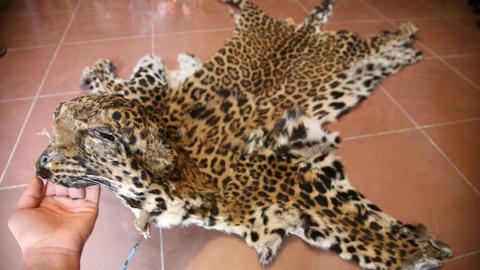14 May 2009 - In May 1507 during a punitive raid into the plains south of Ghazni, the future Mughal Emperor Babur, describes how he and his horsemen took a day off from slaughtering rebellious Afghan tribesmen, to have a day’s hunting on the Dasht-e-Katawaz.
“Next day, when we had ridden from that camp, a hunting circle was formed on the plain of Katawaz where kiyik (gazelle) and wild-ass are always plentiful and fat. Masses went into the ring; masses were killed.”
Three years earlier in June 1504 whilst on another ‘raid’ in the same area he describes how when still some two miles from an alkali lake south of Ghazni, the Ab-e Istada, they saw something like a cloud: “…as red as the rose of the dawn, that kept shewing and vanishing between the sky and the water” which on riding closer they saw to be a mass of birds which he describes as “geese”, but which in fact were immense flocks of “not 10,000 nor even 20,000 but innumerable” flamingos.
In another chapter Babur describes the hunting and killing of three rhinoceros in the jungles that then existed near Peshawar.
Alas, in Afghanistan today the idea of such a profusion of birds and beasts is the stuff of dreams.
The Babur-Nama is full of acute descriptions of wild-life, birds, animals and fishes as well as the flowers, plants and trees that he observed on his travels, even in the midst of his wanderings and campaigns in Central Asia, what is now Afghanistan and northern India (Hindustan).
Some observations had been made by earlier European travellers, most notably Marco Polo in the early 14th century, who described the massive wild rams that he encountered in the Wakhan and Pamir on his way to visit the court of the Great Khan in China.
But, we have to wait until the observations made by travellers, diplomats and spies in the 19th century had matured into a more systematic scientific approach to identification, listing and cataloguing of the fauna and flora of the land space that is now Afghanistan to know what was there.
Not until the 1950s into the 1970s did serious studies of habits and habitat start and international and national concern was aroused into protecting what remained of the country’s rapidly vanishing wildlife. It was during this time that serious initiatives were started to establish internationally recognized protected areas mainly based on existing Royal hunting preserves.
Unfortunately the advent of revolution and war in 1978/1979 meant that only the Big Pamir Wildlife Reserve had been officially gazetted before this work had to stop.
The list of Afghanistan’s wildlife today, after years of conflict, drought and absence of government, in a land awash with arms, reads more like an obituary.
Afghanistan once boasted of being the home of such wonderful animals as the Asiatic cheetah once tamed and trained by princes for the hunt, as portrayed in Mughal and Persian miniatures.
Tracks of what must surely have been the last Caspian tiger in Afghanistan were reported from the Darqhan islands in the Amu Darya River as recently as 1967 and the last wild ass were reported from Badgyz in 1965.
Between 50 and 60 Asiatic cheetah still survive in the deserts of Iran, but nowhere else and a few scattered family groups of wild ass (the onegar) still hang on in the deserts of Iran, Turkmenstan and North West India.
Among the two most notable animals that have managed to survive, against all odds because of the remoteness of their habitat in the Wakhan Corridor and Pamir Mountains, are the snow leopard and Marco Polo’s wild sheep
These two iconic animals share their mountain habitat with the Siberian ibex, brown bears, leopard, grey wolves, the Eurasian lynx, foxes, badgers, various wild cats, martens and marmots as well as Wakhi and Kyrgyz herders with their sheep, goats, yaks, cattle and Bactrian camels.
It is a delicate relationship in which competition for grazing and humans hunting for meat and pelts on one part and predation on the domestic herds by the larger carnivores, in particular snow leopards and wolves, makes for many points of conflict that have somehow to be resolved.
Snow leopard in particular have a tendency to raid the herders’ stock corrals in the winter and indulge in mass slaughter in which act they also often meet their end at the hands of irate herdsmen.
The wild sheep of the Pamir with their magnificent spiralling horns, which have been known to measure almost 200 cm down the outer curve, were first brought to the attention of a sceptical Europe by Marco Polo.
It is not known exactly how many Marco Polo sheep remain in the Afghan Pamir and there is a certain amount of seasonal migration of mature rams between Afghanistan and the countries that share the same mountain ranges, particularly Tajikistan.
Throughout all its range from Afghanistan to China and Mongolia the snow leopard is under severe threat, but against all odds there is strong evidence that a surviving population exists in the eastern Wakhan.
An UNEP expedition in 2002 found fresh tracks in the snow in several locations and recorded a mass of anecdotal evidence provided by local villagers and herders, relating to snow leopard as well as bears, wolves and other denizens of the high mountains.
The problems facing the wide variety of Afghanistan’s fauna and flora, great and small are extremely serious and must not be forgotten.
In a poor rural country such as Afghanistan with its rapidly growing population it is a question of how to provide protection for the wider biodiversity within a human landscape of farmers and herders whose willing cooperation and participation is essential.
Against the odds and in a situation of increasing insecurity, lack of resources, local incapacity, competing national priorities and bureaucratic hurdles, brave efforts are being made to protect what remains of Afghanistan’s once rich biodiversity.
Sadly in Afghanistan, as it exists at present, effective controls on the hunting of rare species for meat or their fur remain almost impossibly difficult to manage.
Although the legal framework is there in theory, effective policing and warden ship is very difficult and administrations have many other problems and priorities to deal with.
By Anthony Fitzherbert
Anthony Fitzherbert has a professional background in agriculture/livestock husbandry, rural development and natural resource management and has had a lifelong interest in the fauna and flora of the region and the natural world. He has worked and travelled extensively in almost all parts of Afghanistan since he first visited the country in 1971 through to the present time and is still a regular working visitor to the country. As well as Afghanistan he has worked and travelled extensively in most of the countries of the region including Iran, Turkey, Pakistan, the Central Asian Republics of Kyrgyzstan and Tajikistan and the Kurdish governorates of northern Iraq. In September/October 2002 he led the UNEP Post Conflict Assessment Mission to the Wakhan and the Big Pamir.
This article appears in the latest issue of the UNAMA Afghan Update magazine on the environment.
To download the magazine in English, Dari and Pashto please click here.






